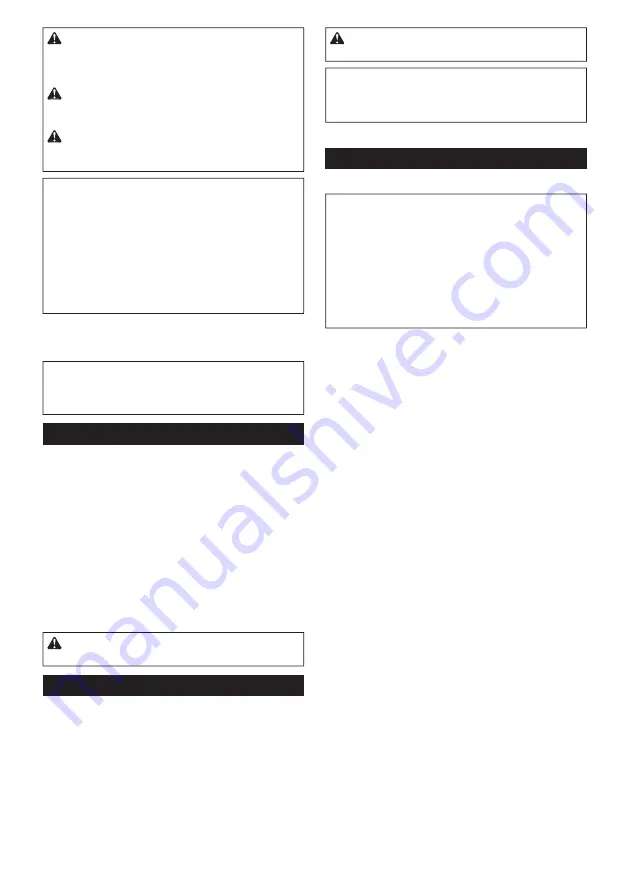
21 ENGLISH
CAUTION:
Always be careful not to over-in
-
flate inflatables during operation.
It otherwise may
burst the inflatables, possibly causing damage to the
tool and personal injury.
CAUTION:
Never leave the tool unattended
while the nozzle is attached to inflatables or
during operation.
CAUTION:
Be aware that heated air stream
may flow through the air vent hole at bottleneck
of the pinch valve nozzle due to air circulation.
NOTE:
Make sure to insert the pinch valve nozzle
fully through the air inlet so the nozzle head serves to
open the flap valve inside the air inlet.
NOTE:
For an inflatable item with a small air inlet
opening, insert the narrow tip of the pinch valve noz-
zle in the air inlet until the bottleneck of the nozzle
head touches the rim of the air inlet.
NOTE:
For an inflatable item with a large air inlet
opening, insert the pinch valve nozzle head fully into
the air inlet to open the flap valve inside the air inlet.
►
Fig.35:
1.
Flap valve
2.
Small air inlet opening
3.
Large air inlet opening
4.
Bottleneck
5.
Air vent hole
NOTE:
If an air inlet on an inflatable item is relatively
smaller than the pinch valve nozzle head, squeeze
and enlarge the air inlet by hand and then twist and
hold the nozzle head into the air inlet.
Blowing in holes and narrow spots
Optional accessory
Recommended nozzles
—
Long nozzles set
Clean dust out of small holes and narrow spots. Nozzle
lengths can be arranged according to your requirements.
Assemble the long nozzle R and F together to allow a
longer operating range, for instance, cleaning anchor
holes at your feet.
►
Fig.36
Use the long nozzle R only to have a shorter operating
range, for instance, cleaning spots on the wall.
►
Fig.37
CAUTION:
Use personal protective equip
-
ment such as a dust mask and eye protection.
Blowing in narrow spaces
Optional accessory
Recommended nozzles
—
Flexible nozzle 6
Blow dust out of any hard-to-reach spots. Highly effec
-
tive for engine cleaning, in-car dust removal, computer
case dust blowing.
Point the nozzle at an angle within touching distance,
and blow back and forth to clean out lingering dust.
Change angles of the nozzle as you blow off to help
blow out some of the tougher pieces of debris and dust.
►
Fig.38
CAUTION:
Use personal protective equip
-
ment such as a dust mask and eye protection.
NOTICE:
Avoid blocking the air vent holes
around the flexible hose end.
It otherwise may
cause sudden noise and vibrations and could possi-
bly affect the tool performance.
►
Fig.39:
1.
Air vent holes
Deflating plastic inflatables
Optional accessory
NOTICE:
Avoid deflating inflatable items in wet
and dusty conditions since water, dust, and sim
-
ilar external substances on surfaces may reach
into the motor causing damages to the tool. Dry
and clean inflatables off thoroughly before per
-
forming deflating operation.
NOTICE:
Never leave the tool unattended while
deflating inflatables. Running the motor contin
-
uously after deflation is completed may cause
overheating.
Recommended nozzles and attachments
—
Air vent hose complete
—
Pinch valve nozzle
—
Rubber attachment
20 - 30
—
Rubber attachment
65
Deflate inflatable items with proper nozzles according to
your preferences and applications.
1.
Place a nozzle or rubber attachment onto the air
vent hose complete.
2.
Replace the dust cap on the suction inlet of the
tool with the air vent hose complete.
3.
Insert the nozzle into the air valve or place the
attachment over the air valve on inflatable items, and
pull the switch trigger to start deflating.
4.
Slowly release the switch trigger to reduce suc-
tion volume as an inflatable item comes close to fully
deflated.
5.
Remove the nozzle or attachment from the air
valve after stopping the air flow and then close the air
valve.
With pinch valve nozzle
►
Fig.40
With rubber attachment 20 - 30
►
Fig.41
With rubber attachment 65
►
Fig.42
Summary of Contents for AS001G
Page 2: ...1 1 2 2 3 Fig 1 1 2 Fig 2 2 1 Fig 3 1 2 Fig 4 1 2 3 4 Fig 5 2 4 3 1 Fig 6 2 ...
Page 3: ...1 2 3 Fig 7 1 2 Fig 8 1 2 Fig 9 1 2 3 4 5 6 Fig 10 2 1 3 4 5 Fig 11 1 1 2 3 Fig 12 3 ...
Page 4: ...1 2 Fig 13 1 2 3 4 Fig 14 1 4 5 3 2 Fig 15 1 2 3 4 Fig 16 2 4 3 1 Fig 17 4 ...
Page 6: ...1 2 Fig 25 1 2 3 3 1 2 Fig 26 Fig 27 Fig 28 Fig 29 1 2 Fig 30 Fig 31 Fig 32 6 ...
Page 7: ...Fig 33 Fig 34 1 1 2 3 4 5 4 Fig 35 Fig 36 Fig 37 Fig 38 1 Fig 39 Fig 40 7 ...
Page 8: ...Fig 41 Fig 42 1 2 3 4 Fig 43 1 Fig 44 1 Fig 45 Fig 46 Fig 47 1 Fig 48 8 ...
Page 9: ...2 4 3 1 Fig 49 9 ...
Page 159: ...159 ...
















































